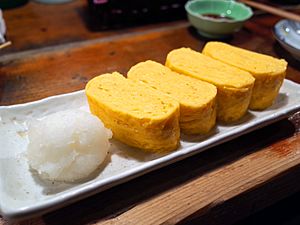Makiyakinabe facts for kids
Makiyakinabe are special square or rectangular cooking pans. They are used to make a popular Japanese dish called tamagoyaki. This dish is a type of rolled omelette. These pans are often made from metals like copper or tin. Some also have a non-stick surface to make cooking easier.
The size and shape of these pans can be different depending on where you are in Japan. But they are always rectangular. Rolled omelettes made with a makiyakinabe are often served as a side dish. You might find them in sushi or bentō lunch boxes.
What's in a Name?
People use a few different names for this pan. Some call it makiyakinabe (巻き焼き鍋). Others use tamagoyaki-ki (玉子焼き器) or tamagoyakinabe (玉子焼き鍋). Sometimes, it's just called a Japanese omelette pan.
The name makiyakinabe comes from three Japanese words. maki (巻き) means "roll." yaki (焼き) means "cooking over heat." And nabe (鍋) means "pan." So, it's a "roll-cook pan." The names tamagoyaki-ki and tamagoyakinabe refer to the rolled omelettes themselves. ki (器) means "tool" or "implement."
How It's Designed and Used
The rectangular shape of the pan is very helpful. It makes sure the omelette has a constant thickness as you roll it. This gives the omelette its neat, bar-like shape. Many professional pans are made of heavy copper. They are often coated with tin. These materials are great because they spread heat very well. You can also find cheaper pans with a non-stick coating.
There are three main types of makiyakinabe pans:
- Kantō-type: These pans are square.
- Kansai-type: These pans are tall and thin rectangles.
- Nagoya-type: These pans are short and wide rectangles.
In the Kantō region, people often use a thick wooden lid with their makiyakinabe. This lid helps them flip the omelette easily.
In Japanese cuisine, these pans are used to make sweet or savory tamagoyaki. Sometimes, if dashi (a Japanese broth) is used, it's called dashimaki tamago. You can also make very thin omelettes called usuyaki tamago.
To make a tamagoyaki, you start with a thin layer of egg mixture in the pan. Before it cooks completely, you fold about a third of it over. You can use Japanese kitchen chopsticks to do this. Then, you flip the folded part onto the rest of the egg. You add more beaten egg mixture, and repeat the folding and rolling. The final result is a thick, rectangular block of layered omelette.
It's important to put only a very thin layer of oil in the pan. Cooks often wipe the pan with a paper towel or cloth that has a little oil on it. Sometimes, a piece of absorbent cotton is used for this. Some recipes say the egg should not brown at all. But in other recipes, it's okay for the layers to turn a golden-brown color.
All About Tamagoyaki
The rolled omelette made in a makiyakinabe is often used as a topping. It's popular on nigirizushi, which is a type of sushi. Some sushi chefs make special versions of the omelette. They mix eggs with shrimp paste and grated yamatoimo (a type of yam). This mixture is very thick. Instead of cooking it in layers, they pour it all into the pan. It cooks for about 30 minutes. Then, they flip it so both the top and bottom turn a brown color. The inside stays yellow and soft.
The thickness of the omelette can vary. Thinner omelettes are sometimes used as decorations. They can also be shaped into pouches and filled with sushi rice. Thicker omelettes are more common. They are used for nigirizushi and in chirashizushi bowls. When the omelette is shredded and used as a garnish, it's called kinshi tamago. This means "golden thread egg."
You can eat tamagoyaki as a snack, a side dish, or for breakfast. It is also a very common item found in bentō lunch boxes.
See also
 In Spanish: Makiyakinabe para niños
In Spanish: Makiyakinabe para niños



